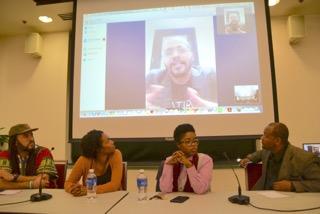November 5, 2015

Justice. Equality. Change. Freedom. These were just some of the terms the crowd shouted back, when Toni Guinyard, reporter, journalist and moderator for the evening, asked the crowd what the Black Lives Matter (BLM) movement meant to them.
“We all have a different perception because our realities are not the same,” said Guinyard, who reports for NBC4. “We are different. It’s OK, we’re supposed to be. We are supposed to think differently.”
The BLM Symposium, co-sponsored by CSUN’s National Association of Black Journalists (NABJ) chapter and the Civil Discourse and Social Change Initiative (CDSC) drew a big crowd. Some were journalism students getting insights in reporting on social movements, others were just interested in “the challenges and successes of “Blacktivism,” as the event would revolve around, according to the invitation.
But as Guinyard explained, the event was also organized to encourage discussions on subjects that can be difficult and uncomfortable to discuss.
“What we are going to, hopefully, get to tonight, is the fact that we can talk about things that makes you feel a little uncomfortable, race being one of them. Because it’s what we don’t want to bring up that we have the most opinions about,” said Toni Guinyard at the Nov. 4 event on campus.
From the audience, graduate student David Leon Stamps agreed that it is challenging talking about race. He explained how people often see him as aggressive or even threatening when participating in conversations about the BLM movement.
“I think, for me, one of the scariest things, especially being a black face in a white place, is not coming across as angry and having a conversation and engaging to a level that people are receptive to,” said Stamps, who is majoring in mass communication. “It’s one thing to be a black journalist and have people looking at you (thinking) ‘Can you be objective?’ It’s another thing to be a black person and have people looking at you and say ‘You cannot objectively engage in this conversation.’ ”
As Guinyard turned to the panel, consisting of four prominent activists with four different backgrounds, she asked them whether a BLM movement is even necessary.
“Without a movement, we would not be here talking about this right now. We really need to have a movement like Black Lives Matter,” said Pan-African Studies Assistant Professor Anthony Ratcliff. “It takes people getting in the streets and demanding change. We have to say ‘no more.’ ”
Povi-Tamu Bryant, program coordinator for inter-ethnic relations, was very articulate about the amplification and multiplicity of the movement.
“Black Lives Matter, as a movement, is a continuation of the black liberation struggle. It was actually the multiplicity of deaths that we were experiencing that lead to lots of people coming out on the streets. It was more a case of a ‘not one more’,” said Bryant.
Ryann Perkins, vice president of CSUN’s NABJ chapter and panelist, agreed and added that the movement is also needed because media does not always capture everything.
“Sometimes a lot of things get lost in the media, when you leave it up to the media to feed you information,” said Perkins.
When moderator Guinyard asked the panelists why the BLM movement sees a need to be ‘in you face’, Ratcliff explained that it’s about using power to demand a change.
“We have to use our power to tell folks that we demand change. I’m not going to just wait for it to happen, I’m going to demand it,” said Ratcliff.
Najee Ali, award-winning nationally celebrated civil right activist, was also a panelist at the BLM symposium and addressed the importance of a united front involving various approaches.
“It’s very important that we remain united and try to support each other even though we may not use the same strategies,” said Ali.
Bryant, who is also part of the BLM movement in L.A., acknowledged the diversity within the movement.
“We are really kind of trying to span the spectrum of black identity, knowing that there’s not one black experience, not one black voice, not one black strategy, not one black tactic, not one black approach,” said Bryant.
As Bryant expressed, the BLM movement goes beyond the national boarders. It is, in fact, an international movement. The BLM movement consists of 28 chapters, 26 within the U.S., one in Ghana and one in Toronto, Canada. Some of these chapters focus on youth development, others on disrupting elected officials, some on amplifying issues on gender and queerness.
“Each chapter is really developing what it needs based on the needs of the community. We are building massively, but we are also building slowly and strategically. It is a slow-moving process, but it is a process,” said Bryant. “It’s amplifying our voices, amplifying our resistance and allowing us to resist together, across the nation and across the world.”
Before the audience broke into three workshops—for journalists, public relations and activism— Wesley Lowery, Washington Post reporter who joined in via Skype, gave his advice to the students in the audience planning journalism careers.
“The more you write, the better you are going to be at writing. The more you report the better you are going to be at reporting,” said Lowery, who covers law enforcement and justice. “It’s really important to get as much experience as possible, so that when you get that moment you know what you’re doing.”
— Trine Bay Larsen, graduate student
